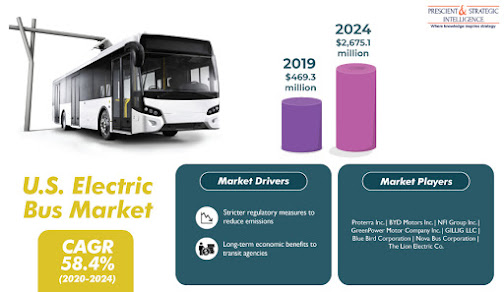Backed by Favorable Government Policies, Electric Bus Sales to Climb in Future in U.S.
The U.S. electric bus market growth will be driven, by factors such as stringent emission norms in the country, environmental benefits of electric vehicles (EVs), favorable government policies to support EVs, long-term operational cost benefits offered by these buses to transit agencies, at a CAGR of 58.4% during the forecast period (2020–2024). The market generated $469.3 million revenue in 2019 and it is projected to reach $2,675.1 million by 2024. Moreover, the declining cost and rising efficiency of automobile batteries will facilitate market growth in the foreseeable future.
 |
| Request to Get the Sample Report |
Moreover, environmental advantage of these vehicles is the strongest driver of the market. The U.S. is the second-largest emitter of carbon after China and the Environmental Protection Agency (EPA) states that transportation sector of the country emits a considerable amount of carbon. To mitigate this critical issue, federal and state governments is encouraging fleet owners and transit agencies to adopt EVs, as these do not have an internal combustion engine (ICE). Even if they have an ICE, which is being used in conjunction with electric motor, they emit very less carbon.
Additionally, the growing adoption of depot-charging buses over en-route charging buses has become a key trend in the U.S. electric bus market, in the recent years. At early stages, most of the electric buses in the country operated on small-sized batteries, which require frequent charging. Whereas, the depot-charging buses have larger batteries that need an overnight charging, thereby, making them operationally similar to traditional diesel buses. Furthermore, the constant improvements in battery technology have led to the introduction of longer-driving range electric buses in the country.
Categories under the vehicle type segment of the U.S. electric bus market include hybrid electric bus (HEB), battery electric bus (BEB), and plug-in hybrid electric bus (PHEB). Among these, the HEB category accounted for the largest market share in 2019, due to the strong penetration of hybrid electric technology in passenger cars. This technology was also induced in conventional buses before the advent of pure-electric technology. Whereas, the BEB category is set to record the fastest growth during the forecast period, as it is the cleanest of all electric buses.
The U.S. electric bus market is consolidated with the presence of a handful of companies. To gain from emerging opportunities, leading automobile manufacturers are focusing on winning client contracts to supply their buses to a large number of transit agencies. For instance, in August 2018, BYD Company Ltd. signed a contract with the state of Georgia to provide electric buses. Similarly, in October 2018,Proterra Inc. received an order from the Rhode Island Public Transit Authority (RIPTA) to deliver three of its 40-foot Proterra Catalyst E2 electric buses to the latter.
Make Enquiry Before Buying the Report: https://www.psmarketresearch.com/send-enquiry?enquiry-url=us-electric-bus-market
Thus, with the rising subsidies and investments from the federal, state, and local governments of the U.S. to boost the adoption of EVs, the demand for electric buses will amplify significantly in the foreseeable future.



Comments
Post a Comment